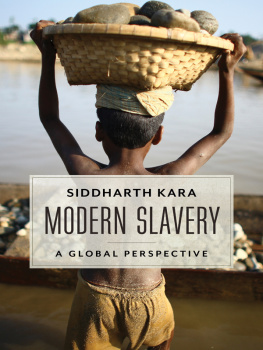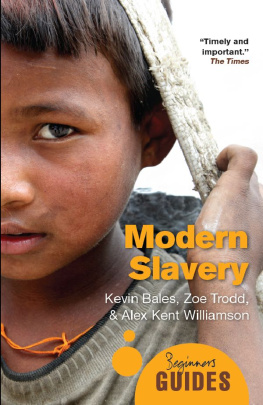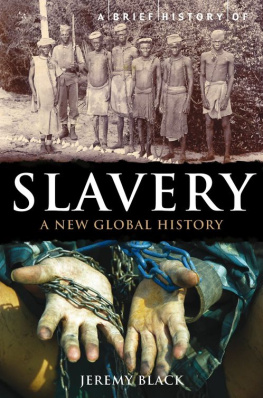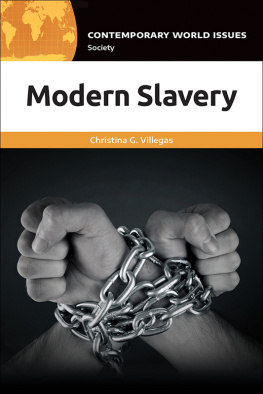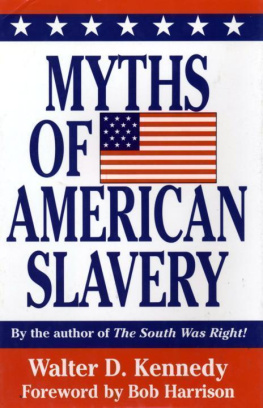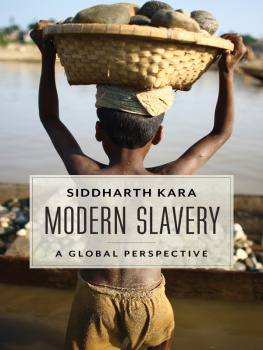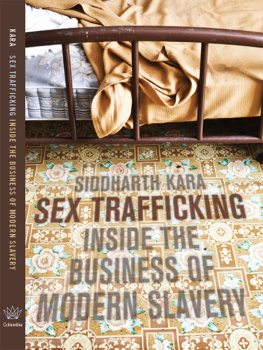Table of Contents
MODERN SLAVERY
SIDDHARTH KARA
MODERN SLAVERY
A GLOBAL PERSPECTIVE
Columbia University Press
New York
Columbia University Press
Publishers Since 1893
New York Chichester, West Sussex
cup.columbia.edu
Copyright 2017 Siddharth Ashok Kara
All rights reserved
E-ISBN 978-0-231-52802-3
Library of Congress Cataloging-in-Publication Data
Names: Kara, Siddharth, author.
Title: Modern slavery: a global perspective / Siddharth Kara.
Description: New York: Columbia University Press, [2017] | Includes bibliographical references and index.
Identifiers: LCCN 2017021711 (print) | LCCN 2017038682 (ebook) | ISBN 9780231528023 (e-book) | ISBN 9780231158466 (cloth: alk. paper)
Subjects: LCSH: Human trafficking. | Prostitution. | Slavery. | GlobalizationEconomic aspects.
Classification: LCC HQ281 (ebook) | LCC HQ281 .K367 2017 (print) | DDC 306.3/62dc23
LC record available at https://lccn.loc.gov/2017021711
A Columbia University Press E-book.
CUP would be pleased to hear about your reading experience with this e-book at .
Cover design: Lisa Hamm
Cover image: G.M.B. Akash / Panos Pictures
For my mother, Dinaz
CONTENTS


THIS BOOK REPRESENTS the culmination of sixteen years of research into modern slavery. During that time, I have investigated slavery in fifty-one countries and have comprehensively documented the cases of 5,439 slaves of all kinds. I traced human trafficking networks around the globe, witnessed the sale of human beings into slavery on six continents, and confronted some of the traffickers and organized crime networks that exploit people in bondage and servitude. My first book, Sex Trafficking: Inside the Business of Modern Slavery, outlined the most profitable form of slavery the world has ever seen. My second book, Bonded Labor: Tackling the System of Slavery in South Asia, outlined the form of slavery that ensnares more people than all other forms combined. This third book offers my overview of the most pervasive and salient manifestations of contemporary slavery I have documented. It represents the totality of what I know about slavery, the full evolution of my thinking on the topic, and my earnest efforts to contribute to the abolition of this savage institution. I focus on a handful of case studies that manifest many of the most important realities of slavery as they exist in the world todayfrom sex trafficking in Nigeria, to labor trafficking in the agricultural sector of California, to organ trafficking in South Asia and across the U.S.Mexico border, to debt bondage in the construction sectors of Malaysia and Singapore, and finally to slavery in Thailands seafood sector.
In my first two books, I placed a substantial focus on outlining the economic realities and key metrics of slavery as it exists in the world today. When I began my research in the summer of 2000, there was a gaping deficiency in slavery scholarship relating to data, metrics, and basic modeling of the offense. I believe my early work helped shift the mode of inquiry into contemporary forms of slavery by demonstrating the value of a business and economic understanding of the crime, as well as the importance of data and metrics relating to every facet of the offensebe it how many slaves there are by type, the profits generated by specific types of slavery from one country to another, the business models used to exploit slaves, or the expected economic value of a slave to the exploiter. This information was meant to provide baselines for measurement, to frame the scale and functioning of the phenomenon, and to inform antislavery policy and law.
In some sense, my journey into slavery has been the wrong way around. In recent years I have grown somewhat weary of metrics and data in the face of the immeasurable human suffering I have witnessed. The misery, degradation, and debasement of human life that I have seen in brothels, in factories, on ships, in agricultural fields, and in other venues of slave exploitation has taken an immense toll on my mind, heart, and health as well as on my faith in humanity. My arguments on how to rid the world of slavery continue to be data-driven, but in this book I wanted to share with you the clearest possible picture of slavery, just as I have seen itin all its depravity, greed, and disdain. At this stage in my journey, numbers no longer provide the comfort they once did, so I have returned to the beginning and tried to convey to you the torment of the slaves I have met, the forces that perpetuate their servitude, and the challenges I faced in trying to document their suffering. I do so solely in the hope that in some small measure these efforts will contribute to the eradication of this dehumanizing institution. Slavery has been an ignoble stain on the legitimacy of human civilization from the beginning. Although this truth only dawned on our collective consciousness a few centuries ago, the systems and forces that promote slavery remain as pervasive and entrenched in the global economic order as ever. Slavery debases human relations, invalidates the conduct of our lives, and indicts us all as participants in its ignominy. I hope this book will play some small role in moving you to action and will inspire new and more effective efforts to abolish slavery once and for all.

THERE IS NO language to express my gratitude to each and every woman, child, and man who shared their stories with me. The dignity and fortitude of the enslaved and oppressed individuals I met across the years have both humbled and inspired me. They shall never be forgotten.
Hundreds of generous people around the world have contributed to my research during the past sixteen years. From local guides and drivers, to translators, to NGO personnel, to law enforcement, to colleagues and well-wishers in dozens of countriesI could not have completed my research without their assistance. I am especially grateful for all the goodwill I received from strangers, who had no reason to trust me, but without whose aid my research could not have been completed.
I am deeply grateful to my agent and friend Susan Cohen for her indefatigable support of my books, and of me as I struggle through them.
I remain profoundly indebted to my first editor, Peter Dimock, who saw something in me that to this day I do not see myselfthe ability to write these stories. Without his faith and advocacy, my books would not exist.
Columbia University Press has given me a supportive home for my work since the first day they embarked on this campaign with me three books ago. It has been a pleasure being an author under their banner.
I could not have written a word, let alone embarked on so many soul-crushing journeys into the world of bondage and slavery, without the love and support of my family. I write especially in most affectionate memory of my second father, Vijay Shankardass, whose noble example of dignity, honor, and nobility I shall forever strive to achieve.

